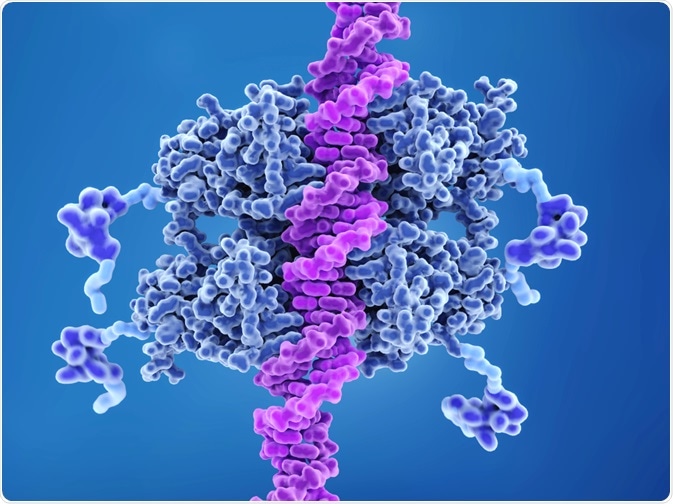Transcription is the process by which DNA is converted into messenger RNA in preparation for translation into a functional product. Extrinsic agents, such as ionizing radiation or chemical mutagen and intrinsic processes, for example, replication fork collapse, may result in cellular double-stranded breaks (DSBs) leading to global genomic instability.
The repair of DSBs requires the use of homologous chromosomes or sister chromatids. The potential for catastrophic consequence underpins the importance of selecting the correct decision between repair and transcription.
Skip to:
- Transcription is a balancing act in E. coli
- RNAP processivity is modulated during DNA damage
- Preventing and repairing DNA damage
- Backtracking of RNAP influences DNA resection
- Summary
 Juan Gaertner | Shutterstock
Juan Gaertner | Shutterstock
Transcription is a balancing act in E. coli
Transcriptional fidelity refers to measures taken by cellular machinery to prevent the incorporation of incorrect bases or stalling of RNA Polymerase during transcription. In E. coli, the transcription factors GreA and GreB (alongside the eukaryotic homolog TFIIS) maintain transcriptional fidelity by preventing base misincorporation and promoting elongation.
Base misincorporation causes RNA to slide backwards in a process known as backtracking; the 3’ end of the nascent (growing) transcript is displaced from the RNAP active site. GreA and TFIIS can rescue RNAP backtracking by cleaving the displaced strand, thereby generating a new error-free 3’ end. This resets RNAP and permits elongation to continue.
In the absence of GreA, mediated by gene deletion, DSB repair improves. This results in both increased backtracking and kinetics of DSB repair via one of two commonly employed pathways: homology‐directed repair pathway (HR) or the alternate pathway non‐homologous end joining (NHEJ). HR is conserved across bacteria, archaea, and eukaryotes preferred as it promotes high-fidelity DSB repair.
RNAP processivity is modulated during DNA damage
Since GreA prevents the repair of double stranded DNA breaks, it has been suggested that RNAP backtracking may be regulated to promote DNA break repair. DSBs trigger the DNA damage (SOS) response in E. coli, which in turn stimulates the expression of genes necessary to inhibit cell division and repair damaged DNA.
However, it is not Gre factors that are targeted through this mechanism but the uvrD helicase gene, and concomitant with its increased expression is its increased dimerization which mediates UvrD's helicase activity to promote RNAP backtracking. As a result, DSBs actively prevent RNAP processivity or the ability of RNAP to catalyze nucleotide polymerization in a continuous fashion.
Preventing and repairing DNA damage
Studies in E. coli have demonstrated that transcriptional fidelity is favored over genome stability. However, this tendency varies across species. For example, D. radiodurans carries out both equally, while D. radiodurans can withstand ionizing radiation, an instigator of DSBs.
It has been suggested that mechanisms that protect the oxidation of the proteome (the cells total protein complement), which compromises its structural and functional integrity and causes cell death, also operate to promote survival in the response to radiation.
RNAP in D. radiodurans is efficient at rescuing backtracking through its ability to carry out transcript cleavage. This, in turn, results in error-free proteins as the transcript produced is high fidelity.
Backtracking of RNAP influences DNA resection
DSB repair begins with resection; the progressive degradation of DNA at the 5’ terminating strand to produce 3’ ssDNA ends that can be loaded with recombination proteins. In E. coli, resection carried out by RecBCD via its unwinding and exonuclease activity. DNA damage is prevented by Chi sites which cause RecBCD pausing and subsequent loading of RecA onto the 3’ssDNA.
RNAP mediated transcription and RecBCD resection co‐occur on the DNA template. Collisions between RecBCD and RNAP may occur; however only 15% of collisions result in RecBCD stalling suggesting transcription does not affect resection, nor does resection promote backtracking of processing RNAP.
Summary
The co-occurrence of the processes of DNA transcription, replication and repair present opportunity for collisions between the various types of machinery. Mechanisms, therefore, exist to prevent deleterious consequences. DNA repair and transcription effectively collude and influence each other to prevent conflict and to promote resolution. Further research is required before a complete understanding of how RNAP processivity resolves the conflict between transcription integrity and DNA repair.
Further Reading